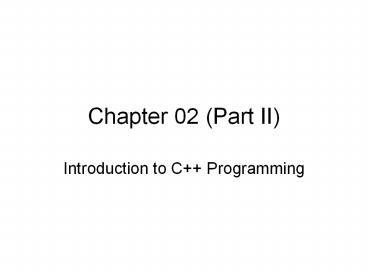Chapter 02 (Part II) - PowerPoint PPT Presentation
1 / 16
Title:
Chapter 02 (Part II)
Description:
How to obtain information from the user. How to perform arithmetic calculations ... Reading variables from memory is nondestructive. Example: sum = number1 number2; ... – PowerPoint PPT presentation
Number of Views:23
Avg rating:3.0/5.0
Title: Chapter 02 (Part II)
1
Chapter 02 (Part II)
- Introduction to C Programming
2
Goal
- Example
- How to obtain information from the user.
- How to perform arithmetic calculations
- Introduction to computer memory.
3
Obtaining Two Integers and Summing Them Up
4
Variables
- We can store data in variables.
- Variable must be declared with name and data type
before used. - For example
- int integer1
- int integer2
- Several variables of same type can be written in
one declaration. For example, - int interger1, integer2, sum
Data type
Variable name
5
Principles of naming a Variable
- The declaration of variables (in a block) cannot
be duplicate. - Use identifiers of 31 characters or fewer to
ensure portability. - Choosing meaningful identifiers.
- Avoid identifiers that begin with underscores.
- Always place a blank line between a declaration
and adjacent executable statements.
6
Capturing Input
- Input stream object
- stdcin
- Usually connected to keyboard
- Stream extraction operator gtgt
- Waits for user to input value until the user
presses Enter. - Stores value in variable to right of the operator
- Converts value to variable data type
- Example
- stdcin gtgt number1
- Reads an integer typed at the keyboard
- Stores the integer in variable number1
7
Adding integers
- Assignment operator
- Assigns value on right to variable on left
- (correct) x 3
- (error) 3 x
- Binary operator (two operands)
- lvalue rvalue
- Example
- sum integer1 integer2
- Adding the values of integer1 and integer2
- Storing result in sum
- Remember the direction of assigning a value!
- int x 3
- int y x 2
8
Outputting the Result
- Stream manipulator stdendl
- Outputs a newline.
- Flushes output buffer.
- Concatenating stream insertion operations
- Also called chaining or cascading.
- Stream insertion operator knows how to output
each type of data. - Example
sum number1 number2 stdcout ltlt "Sum is
stdcout ltlt sum stdcout ltlt stdendl
stdcout ltlt "Sum is " ltlt number1 number2 ltlt
stdendl
Outputs "Sum is Then, outputs sum of number1
and number2 Then, outputs newline and flushes
output buffer
9
Obtaining Two Integers and Summing Them Up
10
2.5 Memory Concept
- Variable names
- Correspond to actual locations (addresses) in
computer's memory - Every variable has name, type, size and value
11
2.5 Memory Concept
- A compiler maintain a table that maps variable
names to real addresses, and their types (memory
size).
45
72
12
2.5 Memory Concept
- Variable names
- When new value placed into variable, overwrites
old value. - Writing to memory is destructive.
- Reading variables from memory is nondestructive.
- Example
- sum number1 number2
- Value of sum is overwritten.
- Values of number1 and number2 remain intact.
13
2.6 Arithmetic
- Arithmetic operators
- Modulus operator returns remainder
- 7 5 evaluates to 2
- Attempting to use the modulus operator () with
non-integer operands is a compilation error.
14
2.6 Arithmetic (Cont.)
- Straight-line form
- All constants, variables and operators appear in
a straight line - Grouping subexpressions
- Parentheses are used in C expressions to group
subexpressions - Example
- a ( b c )
- Multiple a times the quantity b c
15
2.6 Arithmetic
- Rules of operator precedence
- Operators in parentheses evaluated first.
- Multiplication, division, modulus applied next
- Operators applied from left to right
- Addition, subtraction applied last
- Operators applied from left to right
16
Exercise































